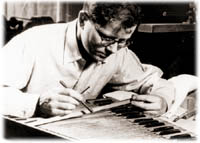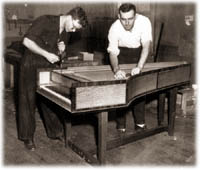|
Ralph Kirkpatrick's Foreward to
"Three Centuries of Harpsichord Making"
by Frank Hubbard
 At some time in the late 1940's, on the
occasion of a concert in Cambridge, I was told of two graduate students in English at
Harvard who had built what I believe was a clavichord. Such reports usually arrive with an
invitation to inspect a cherished and totally unplayable instrument. Having contrived
politely to dodge the invitation, I never found out what the qualities of this instrument
might have been. But not long afterwards it became perfectly clear to me that Frank
Hubbard and William Dowd did not in any way embody the enthusiastic ineptitude that so
frequently is to be encountered among those persons infatuated with old instruments. At
about the same time it must have become clear to these two young men that there was a
mission to perform, that a career in harpsichord building was at the outset more
challenging and in the end perhaps more productive than one in university teaching. The
pursuit of the Ph.D. was dropped, and the two separated for a period of apprenticeship. At some time in the late 1940's, on the
occasion of a concert in Cambridge, I was told of two graduate students in English at
Harvard who had built what I believe was a clavichord. Such reports usually arrive with an
invitation to inspect a cherished and totally unplayable instrument. Having contrived
politely to dodge the invitation, I never found out what the qualities of this instrument
might have been. But not long afterwards it became perfectly clear to me that Frank
Hubbard and William Dowd did not in any way embody the enthusiastic ineptitude that so
frequently is to be encountered among those persons infatuated with old instruments. At
about the same time it must have become clear to these two young men that there was a
mission to perform, that a career in harpsichord building was at the outset more
challenging and in the end perhaps more productive than one in university teaching. The
pursuit of the Ph.D. was dropped, and the two separated for a period of apprenticeship.
Dowd went to Detroit for a year to work in the shop of John
Challis, whose work from the thirties onward, together with that of his teacher and
predecessor of a quarter-century earlier, Arnold Dolmetsch, laid the foundations of
twentieth century harpsichord building in the United States. Frank Hubbard, on his side,
departed for England to gather what he could of the Dolmetsch tradition and to make a
study of ancient keyboard instruments in public and private collections in England and on
the continent.
| At the end of their period of apprenticeship, Hubbard and Dowd returned
to Boston to collaborate in a partnership that lasted until 1958. From this they both
emerged as consummate craftsmen, second to none in skill, intelligence, and experience,
having accomplished the major revolution of this century in harpsichord building. This
revolution was simply to return to seventeenth and eighteenth century traditions and
principles of construction that had hitherto been practiced only in isolated instances. |

Frank Hubbard and William Dowd working on the Hubbard &
Dowd #1,
a Ruckers single manual harpsichord, in 1950.
|
| Without Frank Hubbard's historical studies this would not
have been possible. These studies he pursued at intervals throughout his collaboration
with Dowd and subsequently, to such an extent that he unquestionably knows more about the
history and construction of harpsichords than anyone alive today. The bulk of this
knowledge, guided by the disciplines of the scholar and illuminated by the insights and
experience of the craftsman, is set forth in this book. |
Despite the proliferation of harpsichord builders since the
beginning of this century, there has been regrettably little connection between most
modern harpsichords and their supposed prototypes of the seventeenth and eighteenth
centuries. Modern harpsichord building, since its inception by Pleyel and Erard at the end
of the last century, has been largely in the hands of piano makers dominated by nineteenth
century notions of technological progress. It has seldom occurred to any of them to
question the assumed superiority of modern methods over the experience accumulated by the
great harpsichord makers of an earlier day. (I long ago observed an inveterate temptation
to reinvent the piano.) The traditions of an earlier day, however, were not easy to come
by. Either they were buried in books and documents, hence inaccessible to the
non-scholarly builder, or they were embedded in old instruments that for the most part had
fallen into such neglect or that had been so badly restored that they exhibited few
qualities that seemed worthy of admiration and emulation. Indeed, the condition of most
old instruments would reinforce any piano builder's belief in progress.
If builders were not always equipped to address themselves
to the lessons of the past, scholars and musicians were not always equipped to guide them.
Uncritical acceptance of historic instruments, without rigorous examination of their
history of decay and restoration, has brought about some unfortunate "copies"
and "authentic models." Moreover, sufficient insight into the manner of playing
has often not been available either to scholars or musicians. There were of course
remarkable and fortunate exceptions to these tendencies, most notably set forth in the
early work of Arnold Dolmetsch and in the work of some more recent makers. But the time
has long been ripe for a more adequate fusion of the scholar's knowledge, the musician's
insight, and the builder's craftsmanship. To such a fusion, as represented by the constant
interchange and cross-fertilization among American harpsichord builders, young and serious
harpsichord players, and inquiring and knowledgeable scholars, Frank Hubbard has made an
incalculable contribution.
It is a matter of lasting regret that my friend Raymond
Russell, whose The Harpsichord and Clavichord preceded this book, and who so generously
shared his material with Frank Hubbard, should not have lived to see its influence and
that of the instruments of his collection brought to such a flowering, one that by no
means has ceased to unfold.
The effect of this book for one reader, to speak for
myself, has been to clear away many of the preconceptions and erroneous notions with which
the aesthetic of the modern harpsichord has been burdened. It immensely clarifies the
performer's ideas of the manner in which harpsichord composers used the instruments
available to them, and it makes possible for the harpsichord builder a total and in many
cases highly desirable re-examination of his craft. It is unlikely that a book will soon
appear that will have such far-reaching influence in the harpsichord world.
* Published in 1965 by Harvard University Press.


|